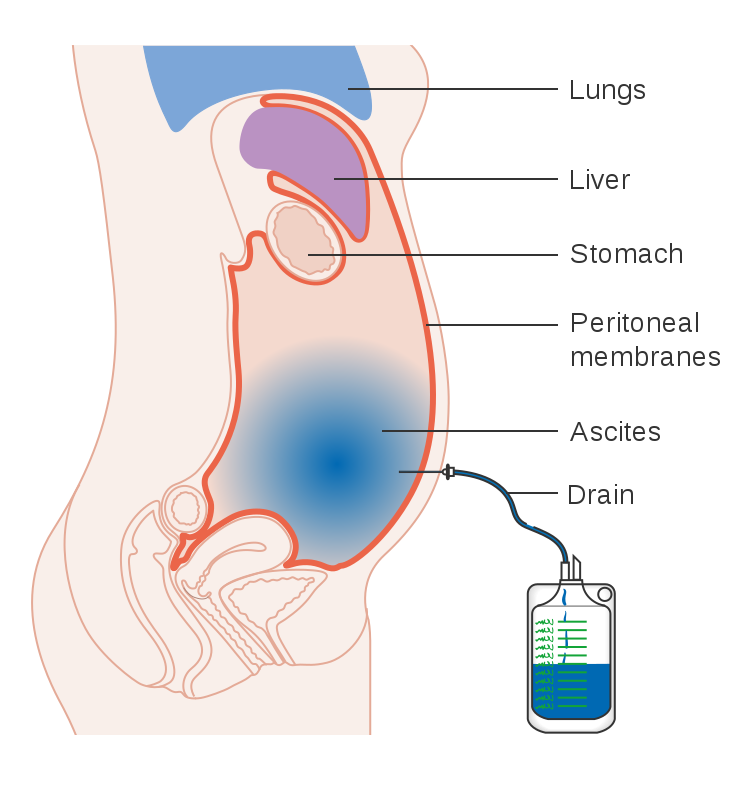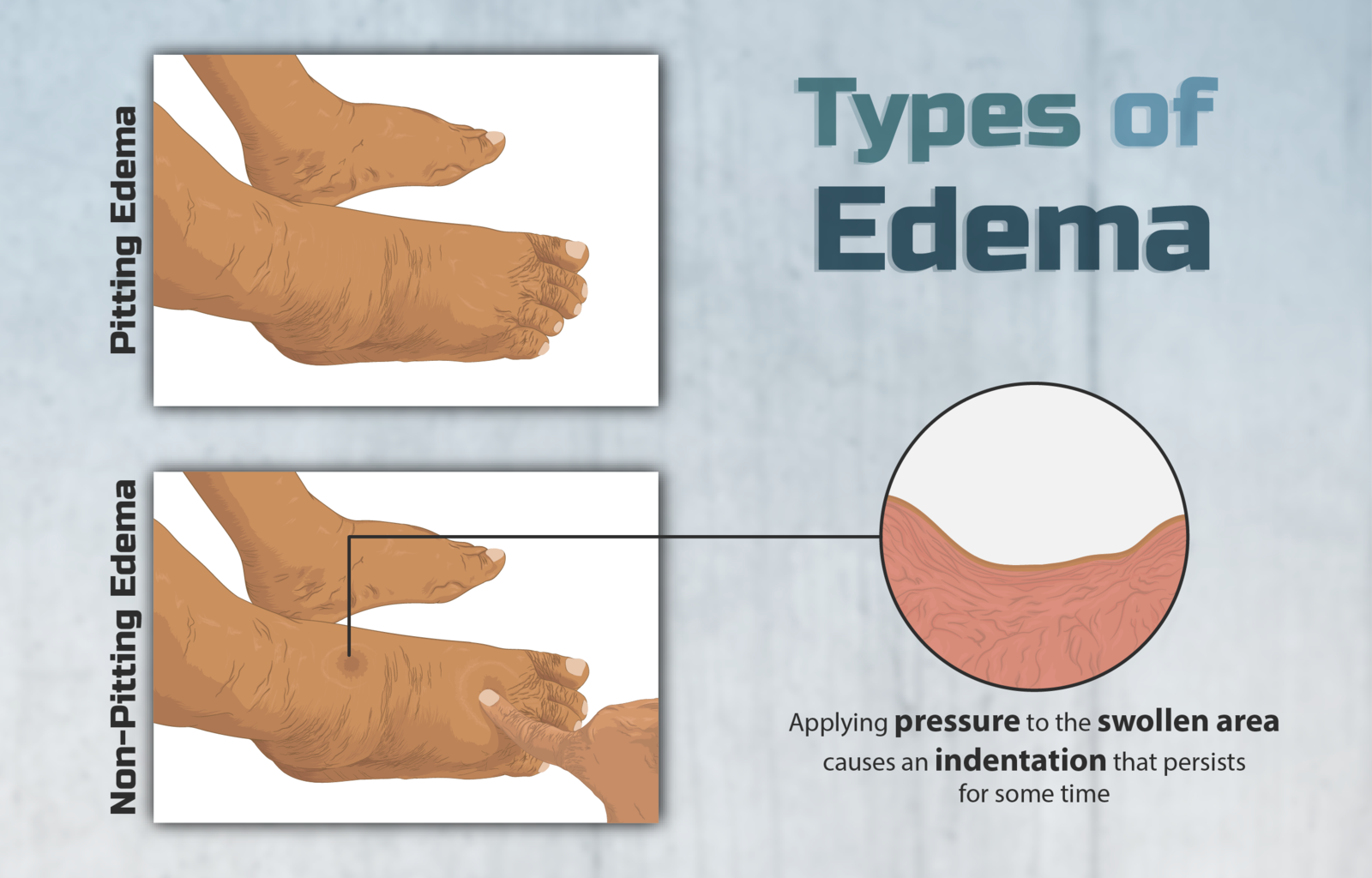Difference Between Ascites and Edema
Both ascites and edema involve swelling and underlying conditions. Specifically, ascites is fluid buildup in the abdomen while edema is simply the medical term for swelling Their distinctions are discussed below.

What is Ascites?
Ascites is fluid buildup in the abdomen; it came from the word “askos” (Greek for sac or bag). It occurs between the two membrane layers which line the abdominal cavity. Ascites’ symptoms include bloating, abdominal swelling, vomiting, urinary urgency, increase of weight, feeling heavy, feeling full, lower leg swelling, back pain, and abdominal pain (Johns Hopkins, 2021). Ascites is a symptom of another condition such as liver disease, cancer, and heart failure. Other typical causes include diseases involving the kidneys, lungs, pancreas, and thyroid (Ingleson, 2017).
The treatments include diuretics, removing excess fluid by inserting a needle into the belly, decreasing salt intake, and lessening fluid intake. If the aforementioned options fail to relieve ascites, surgery (i.e., portosystemic shunting, peritoneovenous shunting, or liver transplantation) may be considered (Nazario, 2020).

What is Edema?
Edema came from the Greek word “oidein” which means “to swell”. It is the swelling and puffiness in the different parts of the body, usually in the skin. Hence, it is simply the medical term for swelling. It occurs when too much fluid is trapped in the tissues, often in the hands, arms, legs, ankles, and feet. It may also affect the brain, eyes, lungs, muscles, and bowel. Edema is a common condition specially for pregnant and older people; however, it can also signal a serious condition. It generally starts slowly but it can also have a sudden onset (Brazier, 2021).
Edema has many causes such as varicose veins, too much salt intake, prolonged sitting or standing, and side effects of medications (i.e., those prescribed for diabetes, high blood pressure, inflammation, and pain). It is also often a symptom of a certain illness such as kidney disease, heart failure, liver issues, thyroid disorders, infections, allergies, and blood clots (Heitz, 2019).
The symptoms of edema depend on the affected area, the amount of swelling, and the cause. For instance, an allergic reaction due to a bee sting on the leg may cause swelling on the entire leg, pain, and limping. In comparison, allergic reactions to medicine and food may cause swelling in the tongue or throat which may inhibit breathing. As for the leg edema due to heart disease, the swelling may lead to an added 10 or 20 pounds which can disrupt blood flow and cause skin ulcers. People with pulmonary edema experience shortness of breath and low oxygen levels. Thus, the treatment involves treating the underlying cause. For example, allergy medications may be taken to relieve the swelling from allergies, blood thinners may be prescribed to treat blood clot in the leg which led to edema, diuretics may treat leg edema due to liver disease or congestive heart failure, and limiting sodium intake may also help (Hoffman, 2020).
Difference between Ascites and Edema
Definition
Ascites is fluid buildup in the abdomen while edema is the swelling and puffiness in the different parts of the body; it is simply the medical term for swelling.
Etymology
Ascites came from the Greek word “askos” which translates to “sac” or “bag”. On the other hand, edema came from the Greek word “oidein” which means “to swell”.
Symptoms
Ascites’ symptoms include bloating, abdominal swelling, vomiting, urinary urgency, increase of weight, feeling heavy, feeling full, lower leg swelling, back pain, and abdominal pain (Johns Hopkins, 2021). Regarding edema, the symptoms depend on the affected area, the amount of swelling, and the cause. For instance, an allergic reaction due to a bee sting on the leg may cause swelling on the entire leg, pain, and limping. In comparison, allergic reactions to medicine and food may cause swelling in the tongue or throat which may inhibit breathing. As for the leg edema due to heart disease, the swelling may lead to an added 10 or 20 pounds which can disrupt blood flow and cause skin ulcers. People with pulmonary edema experience shortness of breath and low oxygen levels.
Causes
Ascites is a symptom of another condition such as liver disease, cancer, and heart failure. Other typical causes include diseases involving the kidneys, lungs, pancreas, and thyroid (Ingleson, 2017). In comparison, edema has many causes such as varicose veins, too much salt intake, prolonged sitting or standing, and side effects of medications (i.e., those prescribed for diabetes, high blood pressure, inflammation, and pain). It is also often a symptom of certain illnesses such as kidney disease, heart failure, liver issues, thyroid disorders, infections, allergies, and blood clots (Heitz, 2019).
Treatment
The treatments for ascites include diuretics, removing excess fluid by inserting a needle into the belly, decreasing salt intake, and lessening fluid intake. If the aforementioned options fail to relieve ascites, surgery (i.e., portosystemic shunting, peritoneovenous shunting, or liver transplantation) may be considered (Nazario, 2020). As for edema, the treatment involves treating the underlying cause. For example, allergy medications may be taken to relieve the swelling from allergies, blood thinners may be prescribed to treat blood clot in the leg which led to edema, diuretics may treat leg edema due to liver disease or congestive heart failure, and limiting sodium intake may also help (Hoffman, 2020).
Ascites vs Edema

Frequently Asked Questions:
Does ascites cause edema?
Yes, since the symptoms of ascites include abdominal and leg swelling.
Is ascites hard or soft?
Generally hard; ascites results in a large, protruding, hard belly (Cunha, 2020).
Does ascites cause edema in legs?
Yes, since the symptoms of ascites include leg swelling.
How long can you live with ascites?
The outlook generally depends on the severity and underlying cause. Usually, malignant ascites has a poor prognosis (i.e., mean survival time between 5 to 15 months). Ascites due to advanced liver disease generally has a fair prognosis while ascites due to heart failure has a better prognosis since patients may live years with appropriate treatments (Nabili, 2021).
Will drinking more water help with edema?
Regarding swollen feet, getting enough fluids may help reduce swelling. This may sound counterintuitive; however, when the body is dehydrated, it actually holds on to the fluid it has (Herndon, 2019). It is less likely for a well-hydrated body to retain fluid.
What is the best diuretic for edema?
According to Drugs.com, the drug names with the most reviews in treating edema are furosemide (6.8 rating over 10) and Lasix (6.4 rating over 10). Also, according to GoodPx, the most popular edema drug is prednisone (2021).
Summary
- Ascites is fluid buildup in the abdomen while edema is the swelling and puffiness in the different parts of the body; it is simply the medical term for swelling.
- Ascites’ symptoms include bloating, abdominal swelling, vomiting, urinary urgency, increase of weight, feeling heavy, feeling full, lower leg swelling, back pain, and abdominal pain (Johns Hopkins, 2021).
- Edema’s symptoms depend on the affected area, the amount of swelling, and the cause.
- The treatments for ascites include diuretics, removing excess fluid by inserting a needle into the belly, decreasing salt intake, lessening fluid intake, and surgery. As for edema, the treatment involves treating the underlying cause.
- Difference Between Hematoma and Melanoma - February 9, 2023
- Difference Between Bruising and Necrosis - February 8, 2023
- Difference Between Brain Hematoma and Brain Hemorrhage - February 8, 2023
Search DifferenceBetween.net :
Leave a Response
References :
[0]Brazier, Y. (2021). Everything you need to know about edema. Medical News Today. https://www.medicalnewstoday.com/articles/159111
[1]Centers for Disease Control and Prevention. Assessment for ascites. https://www.cdc.gov/dengue/training/cme/ccm/Assess%20for%20Ascites_F.pdf
[2]Cunha, J. (2020). Ascites vs belly pain. Emedicine health. https://www.emedicinehealth.com/ascites_vs_beer_belly/article_em.htm
[3]Heitz, D. (2019). What you should know about edema. Healthline. https://www.healthline.com/health/edema
[4]Hoffman, M. (2020). What is edema? WebMD. https://www.webmd.com/heart-disease/heart-failure/edema-overview
[5]Ingleson, K. (2017). What to know about ascites. Medical News Today. https://www.medicalnewstoday.com/articles/318775
[6]Johns Hopkins Medicine (2021). Ascites. https://www.hopkinsmedicine.org/health/conditions-and-diseases/ascites
[7]Nabili, S. (2021). Ascites. MedicineNet. https://www.medicinenet.com/ascites/article.htm
[8]Nazario, B. (2020). Ascites. WebMD. https://www.webmd.com/digestive-disorders/ascites-medref
[9]Rushing, J. (2005). Assessing for ascites. Nursing 2021. https://journals.lww.com/nursing/fulltext/2005/02000/assessing_for_ascites.46.aspx
[10]Wint, C. (2019). Ascites causes and risk factors. Healthline. https://www.healthline.com/health/ascites
[11]Image credit: https://commons.wikimedia.org/wiki/File:Depiction_of_different_types_of_Edema.png
[12]Image credit: https://commons.wikimedia.org/wiki/File:Diagram_showing_fluid_(ascites)_being_drained_from_the_abdomen_CRUK_122.svg
